
We have developed an assistive technology for people with vision disabilities of central field loss (CFL) and low contrast sensitivity (LCS). Our technology includes a pair of holographic AR glasses with enhanced image magnification and contrast, for example, highlighting objects, and detecting signs, and words. In contrast to prevailing AR technologies which project either mixed reality objects or virtual objects to the glasses, Our solution fuses real-time sensory information and enhances images from reality. The AR glasses technology has two advantages: it’s relatively ‘fail-safe.” If the battery dies or the processor crashes, the glasses can still function because it is transparent. The AR glasses can also be transformed into a VR or AR simulator when it overlays virtual objects such as pedestrians or vehicles onto the glasses for simulation. The real-time visual enhancement and alert information are overlaid on the transparent glasses. The visual enhancement modules include zooming, Fourier filters, contrast enhancement, and contour overlay. Our preliminary tests with low-vision patients show that the AR glass indeed improved patients' vision and mobility, for example, from 20/80 to 20/25 or 20/30.

In the latter half of the 1980s, PM2.5 pollution in Beijing became a serious problem, and there were concerns about health hazards. It was expected that China's emissions must be reduced from 2013 to 2016, and the lockdown effect of Covid-19 would bring about an end, but it is still reluctant to regulate CO2 emissions. Again, in Beijing in November 2021, a visibility of 500 m or less has been observed, then road traffic is dangerous in addition to health. After that, the center of pollution has moved from India to Mongolia, and now Nepal, Qatar and Saudi Arabia. The situation is still serious in developing countries. Image restoration to remove the effects of haze and fog has been a long-standing concern of NASA, and their original Visual Servo has been put into practical use. Though the mainstream moved to the technique based on atmospheric physics. He et al.'s Dark Channel Priority (DCP) logic has had a certain effect on heavily polluted PM 2.5 scenes , but there is a limit to the restoration of detailed visibility. The observed images are affected by two spatial inhomogeneities of 1) atmospheric layer and 2) illumination. As a countermeasure, we have improved DCP process with the help of Retinex and introduced the veil coefficient as reported in CIC24. Recently, a variety of improvements in single image Dehazing, using FFA-net, BPP-net, LCA-net, or Vision-based model are in progress. However, in each case, visibility of details is still a common problem. This paper proposes an improvement in detail visibility by (1) joint sharpness-contrast preprocess and (2) adjustment in Dehaze effect with veil coefficient v. Lastly, we challenge numerical evaluation of improvement in detail visibility by the two ways of attenuation of high-frequency Fourier spectrum and the expansion rate of the color gamut.

Tone curves are a key feature in any image processing pipeline, and are used to change the pixel values of an input image to find an output image that looks better. Perhaps the most widely deployed tone curve algorithm is Contrast Limited Histogram Equalisation (CLHE). CLHE is an iterative algorithm that tone maps an input image so that the histogram of the output is (approximately) maximally uniform subject to the constraint that the tone curve has bounded slope (neither too large or too small).In this paper, we build upon a neural network framework [1] that was recently developed to deliver CLHE in fewer iterations (each layer in the neural network is analogous to a single iteration of CLHE, but the network has fewer layers than the number of iterations needed by CLHE). The key contribution of this paper is to show that the same network architecture can be used to implement a more complex (and more powerful) tone mapping algorithm. Experiments validate our method.